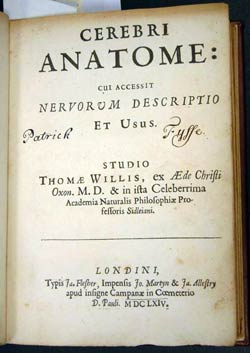Cerebri Anatome
 Book that described and depicted the circle of Willis.
Book that described and depicted the circle of Willis.
The year 2014 marked the 350th anniversary of the publication in London of Cerebri anatome, a ground-breaking work of neuroscience heavily influenced by the political and cultural context of Baroque Europe and mid-17th century England.
In Cerebri anatome, Thomas Willis recognized the cerebral cortex as the substrate of cognition. He also claimed that the painful stimuli came from the meninges, but not from the brain itself. He explained for the first time the pathological and functional meaning of the brain's circular arterial anastomosis, which is named after him. He also specified some features of the cranial origin of the sympathetic nerves and coined the term 'neurologie'. Cerebri anatome marked the transition between the mediaeval and modern notions of brain function, and thus it is considered a cornerstone of clinical and comparative anatomy of the nervous system. The new contributions and methods employed by Willis justify his place as a father of neurology and a pioneer of translational research 1).
https://archive.org/stream/cerebrianatomecu00will#page/n71/mode/2up